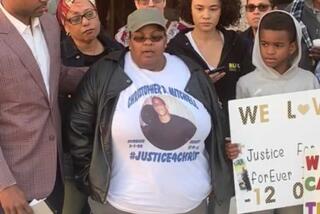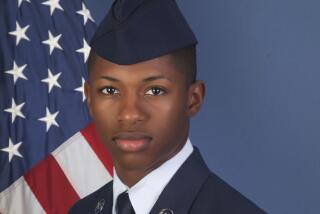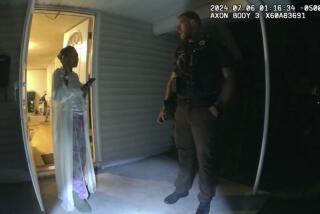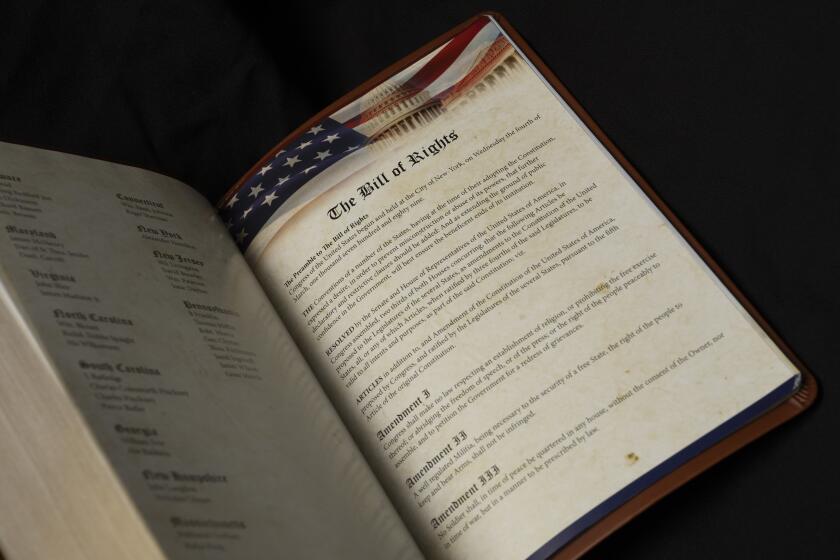Trial’s Focus Shifts to Why Tuffree Shot Simi Officer
By now, the battle lines have been etched with increasing sharpness in the Daniel Allan Tuffree murder trial, as prosecutors prepare this week to rest their case.
Jurors have heard four weeks of testimony about Tuffree’s Valium abuse, hollow point bullets and hatred for police, about Officer Michael Frederick Clark’s psychiatric training, pistol ammunition and gunshot wounds.
They examined the window through which the two men shot each other. They walked through Tuffree’s bullet-pocked living room.
They stood where Clark fell bleeding.
And they have listened to dozens of witnesses describe how Clark came that muggy August afternoon to find out about Tuffree’s health, and wound up losing his life in a brutally short gunfight.
By now, the question of whether Tuffree shot Clark is moot: Tuffree’s attorneys admitted in opening statements that their client fatally wounded the officer.
As defense attorneys prepare to spend a week presenting their own witnesses to explain the shooting, the Tuffree trial will focus more on why.
The prosecution and defense teams offer wildly differing answers, tailored to the verdicts they seek.
Deputy Dist. Attys. Patricia Murphy and Peter Kossoris argue Tuffree, 49, was a longtime cop hater who opened fire on Clark, 28, moments after meeting him, who loaded two big guns with cop-killer bullets and shot to kill.
*
But Deputy Public Defenders Richard Holly and Howard Asher have called the Clark shooting a tragic misunderstanding.
They argue that specially trained psychiatric crisis workers--not heavy-handed police officers--should have been sent to Tuffree’s house when the increasingly frantic man phoned doctors and pharmacists begging for a fresh prescription of Valium.
And they contend Tuffree merely showed his gun to scare Clark off, then shot in self-defense when Clark fired first.
These two versions of why will help jurors answer the trial’s ultimate question:
Did Daniel Allan Tuffree commit premeditated, first-degree murder--a charge that could send Tuffree to execution? Or was it a lesser case of second-degree murder or manslaughter?
The Ventura County district attorney’s office has pulled out all the stops to press its point.
*
Murphy is a seasoned homicide prosecutor. And Kossoris is a veteran trial deputy who won death penalties in the last two high-profile capital cases in the county: for day-care worker Gregory Scott Smith, who killed 8-year-old Paul Bailly; and for Mark Scott Thornton in the carjack slaying of Westlake nurse Kellie O’Sullivan.
Kossoris and Murphy have presented experts on ballistics, police tactics and crime analysis.
They showed the jurors the huge .44-Magnum revolver and .40-caliber Glock pistol Tuffree wielded, along with Clark’s less powerful 9-millimeter Beretta service pistol.
They set up Tuffree’s shattered kitchen window in the courtroom.
They paid a model maker $5,000 to spend 160 hours building a 1/24-scale reproduction of the Tuffree house, complete with lifelike trees and a tiny, rock-rimmed swimming pool.
And they meticulously laid out the chain of events:
Prosecution witnesses testified that Tuffree pestered a string of people--first his doctor’s office, then a pharmacy, then his psychiatrist’s office, then his insurance company.
He wanted an early refill on the most powerful Valium prescription legally available, they testified, because he was downing his pills too fast.
They testified that concern drove them to call mental health crisis workers, then police when it became evident that Tuffree had been mixing alcohol and Valium and refusing to answer his phone.
*
Then the prosecutors put the two men on the stand who were closest witnesses to the gunfight: Simi Valley Police Sgt. Anthony Anzilotti and Officer Michael Pierce.
Coupled with a visit to the Tuffree house last week, the officers’ testimony gave jurors a vivid picture of what happened--from Clark’s first knock at Tuffree’s door to the volley of gunfire in the side yard, to the moment a SWAT truck smashed through Tuffree’s fence to rescue the fallen Clark.
But just as prosecutors have sought to establish Tuffree in jurors’ minds as someone who ambushed Clark and killed him in cold blood, defense attorneys have worked through cross-examination--and the list of witnesses they are preparing to put on--to plant doubt there instead.
Defense attorney Asher told jurors in opening statements that the Tuffree shooting began as a tragically real game of “telephone.”
Tuffree’s original requests for a renewed Valium prescription were twisted, distorted and inflated by repeated inaccurate retellings, Asher told jurors, until Clark showed up at his house believing this:
That Tuffree was heavily abusing Valium. That he was ignoring his psychiatrist to the point where she dropped his case, and that he had attempted suicide and was already lying on the floor of his home in a drunk and drugged stupor.
*
And on cross-examination, Asher got police to admit that instead of checking outside sources on the mental health of a man who they knew to be armed and possibly unstable, they pushed toward a confrontation with guns drawn.
Asher also told jurors in opening statements that when police surprised Tuffree by suddenly barging into his yard and peering through his windows, Tuffree wanted only to send them away.
And he admitted that his client made “a very big mistake” by waving his gun to try to scare them.
The police approach, Asher said, pushed Tuffree to a “fight or flight” decision: “There was very little time for deliberation. There was only time for Mr. Tuffree to react.”
Finally, Asher asked jurors to ask themselves as the trial progresses, “Is it about malice or mistakes? Is it about premeditation or panic?”
After the prosecution rests its case, Asher and co-counsel Holly--who faced Kossoris once before on a death penalty case when he defended Smith--will present their own witnesses.
The public defenders declined to discuss their strategy for the case, particularly whether they intend to call Tuffree to the stand.
But their opening statements signaled much of their defense:
They plan to present Tuffree’s statements in police interviews saying he never intended to kill anyone and expressing surprise that Clark had died.
They will put on their own police-tactics expert to testify that police were overly heavy handed and pushed a simple check-the-welfare call into an armed conflict.
They will point out discrepancies in testimony, including one of the two police officers on the scene who said he never heard Clark fire his gun--when in fact he emptied the pistol.
*
And they will do everything they can to turn jurors toward a lesser verdict that could save Tuffree from the execution chamber.
Throughout the trial, Tuffree has sat quietly at the defense table in a shirt and tie and a succession of gray or dark-blue suit jackets.
He takes notes on a yellow legal pad, whispers to his attorneys and their investigators, and watches intently, occasionally rocking slightly in his chair, as the evidence unfolds.
Behind him sit members of his family, their faces knit in concern. Clark’s family has sat behind the prosecution table for much of the trial, sometimes leaving the courtroom when testimony or evidence is too graphic to bear.
And they are all waiting to see what the jury will do.
(BEGIN TEXT OF INFOBOX / INFOGRAPHIC)
A Fatal Call
No one disputes that Daniel Allan Tuffree shot Simi Valley Police Officer Michael Clark to death. But a jury is being asked to decide whether Tuffree committed first- degree murder that could get him the death penalty, or whether Tuffree faces lesser charges for shooting back in self-defense assuming Clark fired first. So far, prosecution witnesses have described how Clark and two other officers went to check on Tuffree’s health, and wound up in a fatal gunfight:
The Call
1. Clark knocks on front door. There is no answer. He talks to neighbor Ed Lomprey, who says Tuffree is “kind of a nut,” owns a gun and has been known to shoot. Clark calls for his supervisor, Sgt. Anthony Anzilotti. Anzilotti arrives and Clark repeats the neighbor’s warning. Anzilotti tells Clark tht in 1992 he and other Simi Valley officers seized a .40-caliber Glock semautomatic pistol from Tuffree. The gun was later returned to him.
2. Anzilotti and Clark pound on front door. They look through front windows.
3. The officers talk to neighbors and try the locked garage door. Concerned Tuffree may be suffering a medical emergency, Anzilotti radios dispatch and asks them to phone the house.
4. The dispatcher reports the line is busy and has the phone company force the line free. No one answers.
5. Clark and Anzilotti approach backyard. They peer between wooden fence slats, then look over the backyard’s 6-foot block wall.
6. Officer Michael Pierce arrives. As Anzilotti briefs Pierce, Anzilotti reaches over the fence with his baton and unlatches the gate. The police move into the yard, Pierce staying at the gate, Clark going toward the kitchen window, Anzilotti around back.
7. Anzilotti checks rear windows while Clark looks in mirrored side windows. Clark’s hand is on his gun. Anzilotti’s gun is drawn ad pointed down.
The Shooting
8. Tuffree spotted. Clark says, “I see somebody inside” or “I see a shadow.” The officers call Tuffree’s name. Clark asks Tuffree to come out. “What for?” Tuffree responds. “We just want to make sure you’re OK.” “Go away, “Tuffree replies in a slow, slurred voice.
9. Clark demands, “Let me see your hands.” He repeats it several times. Anzilotti moves to join him.
10. Shooting starts. Tuffree brings his hands into view holding a gun. Clark shouts, “He’s got a gun!” and the two begin shooting. Prosecutors later say Tuffree shot first, while defense lawyers argue he shot in self- defense after Clark fired the first shot.
11. Clark dives for cover but falls mortally wounded. His emptied gun is recovered later. Meanwhile, Anzilotti sees Pierce dive onto his belly, yelling, “Shots fired, officer down,” into his radio and shooting rapid- fire at the windows. Tuffree returns fire.
The Rescue
12. Anzilotti vaults the wall, retieves a shotgun and fires at the house. He radios for an ambulance and SWAT team. Pierce and Anzilotti fall back and wait as backup officers flood neighborhood.
13. Crisis negotiators arrive and try contacting Tuffree with a cellular phone, then with loudspeakers. There is no response.
14. SWAT rescue. SWAT commander Lt. Richard Thomas rams an armored truck through the fence. The truck shields Clark from gunfire while SWAT officers drag him to safety and rush him to the hospital.
15. Tuffree arrested. SWAT officers lob tear gas and stun grenades into Tuffree’s living room, then storm the house and place him under arrest.
The Principals
Daniel Tuffree
Officer Clark
Sgt. Anzilotti
Officer Pierce
SWAT and Emergency Team
Researched by MACK REED / Los Angeles Times
More to Read
Sign up for Essential California
The most important California stories and recommendations in your inbox every morning.
You may occasionally receive promotional content from the Los Angeles Times.










